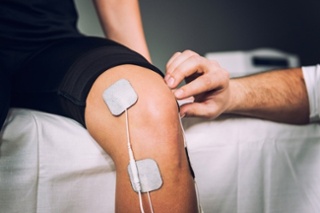
What is the Deal with e-stim?
 Electrical stimulation is a modality used in physical therapy for multiple purposes. I often get the question from patients wondering why some therapists use it and others hardly ever do. It helps to first know a bit more about the purpose or theoretical uses for it. Electrical stimulation, or e-stim, uses electrode pads (often 2 or 4 pads) that are stuck to the skin to carry an electrical impulse to other structures. There are 2 kinds used most commonly in a clinical setting. The first is better known, called TENS-Transcutaneous electrical nerve stimulator. The second is NMES- Neuromuscular electrical stimulation. As the name implies, TENS is used more to modulate pain under the skin, whereas NMES is used more to stimulate a muscle. There is minimal current evidence to show that a TENS unit can change or heal an injured or pathological structure. What the evidence does show is that the signal created by the unit can move quicker to the brain than the sensation of pain can. So, you feel the electrical stimulation instead of the pain for the time the unit is on (and possibly 20-30 min after it is off as well). The NMES has slightly more evidence to show its effectiveness on muscle function. When placed over a motor point of a muscle, it can assist the muscle in a contraction. For example, after knee surgery, disuse and edema cause a person to have a difficult time getting the quadriceps to contract. Placing the pads over the quadriceps and turning it on while actively trying to do a contraction yourself, can together cause a better functioning quadriceps. The stimulation alone has not been shown to be more beneficial, but when used in combination with active muscle contraction it can assist in muscle firing quicker and possible stronger.
Electrical stimulation is a modality used in physical therapy for multiple purposes. I often get the question from patients wondering why some therapists use it and others hardly ever do. It helps to first know a bit more about the purpose or theoretical uses for it. Electrical stimulation, or e-stim, uses electrode pads (often 2 or 4 pads) that are stuck to the skin to carry an electrical impulse to other structures. There are 2 kinds used most commonly in a clinical setting. The first is better known, called TENS-Transcutaneous electrical nerve stimulator. The second is NMES- Neuromuscular electrical stimulation. As the name implies, TENS is used more to modulate pain under the skin, whereas NMES is used more to stimulate a muscle. There is minimal current evidence to show that a TENS unit can change or heal an injured or pathological structure. What the evidence does show is that the signal created by the unit can move quicker to the brain than the sensation of pain can. So, you feel the electrical stimulation instead of the pain for the time the unit is on (and possibly 20-30 min after it is off as well). The NMES has slightly more evidence to show its effectiveness on muscle function. When placed over a motor point of a muscle, it can assist the muscle in a contraction. For example, after knee surgery, disuse and edema cause a person to have a difficult time getting the quadriceps to contract. Placing the pads over the quadriceps and turning it on while actively trying to do a contraction yourself, can together cause a better functioning quadriceps. The stimulation alone has not been shown to be more beneficial, but when used in combination with active muscle contraction it can assist in muscle firing quicker and possible stronger.
So, back to the original question- why do some PT’s use it more than others? In the simplest form, it’s because other treatments are shown to be more effective. PT’s will often use manual therapy, exercise, stretching, etc. first as it has been shown to have better outcomes on pain and function. There are, of course, times that therapists know pain will likely be high, in episodes of chronic pain, or when patients have used it before and found success that PT will use clinical judgement to begin e-stim sooner.